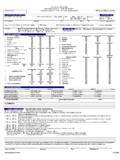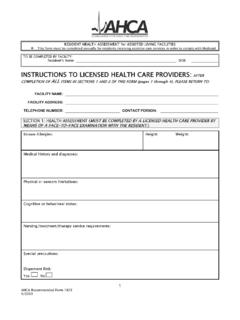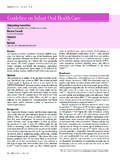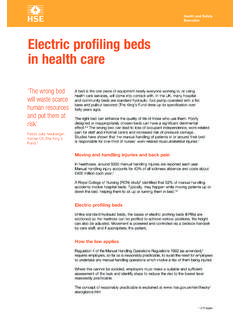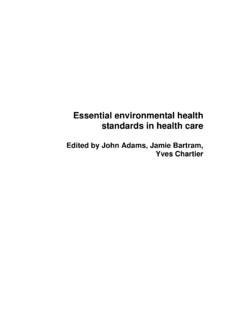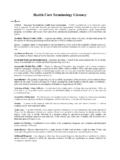Transcription of Health-care waste management • Rapid assessment tool
1 SectionScopeContent1. IntroductionProvides basic information on this Rapid assessment tool2. Checklist for chronological preparation of the assessment3. PlanningPlan for a two week field assessment with a few hints of what to do when4. ContactsContact list to help you keep track with all your main interlocutors5. TerminologyListing of all specific terms used6. tool ANationalQuestionnaire to collect data from associations, NGOs and universities or other research inhave had relevant activities in HCWM in different settings of the tool BNationalQuestionnaire to collect data at Ministerial level8. tool CLocalQuestionnaire to collect data at Municipal Authority level9.
2 Tools DLocalQuestionnaires to collect data from personnel of health care facilities (HCF)10. tool ELocalPersonal observations made during visits of health care facilities11. tool FNationalRating system for the HCWM situation assessed by main headings12. QuestionsComplete listing of all questions existing within the different tools.> To access any of the above "chapters", click on the tabs : World health Organization: / E-mail: Health-care waste management Rapid assessment toolContentContactsWe are interested in your dataThanks to send to WHO a computerised copy of the spreadsheets containing the data you will have collected with this for country levelPreparationpage 1 coverHealth- care waste management Rapid assessment tool1 Introduction In many (mainly low income) countries, improper management of wastes generated in health care facilities causes direct health impacts on the community, the personnelworking in health care facilities, and on the environment.
3 In addition, pollution due to inadequate treatment of waste can cause indirect health effects to the community. Health-care wastes (HCW) includesharps(syringes, disposable scalpels, blades, etc.),non-sharps(swabs, bandages, disposable medical devices, etc.),blood andanatomic waste (blood bags, diagnostic samples, body parts, etc.),chemicals(solvents, disinfectants, etc.),pharmaceuticals, and others, and may be infectious, toxic, This Rapid assessment tool is a part of an overall strategy developed by WHO which aims at reducing the disease burden caused by poor health care waste management (HCWM) through the promotion of best practices and the development of safety Basic assumptions and objectives The basic assumption is that it is possible - in a short period of time (10-15 days)
4 , by questioning main stakeholders and by selecting a number of healthcare facilitiesrepresentative of the country - to gather the essential data necessary to have a sufficient understanding of the situation regarding HCWM at a national level. By analysing the role of each stakeholder along the HCWM stream it should be possible to identify where problems remain and what simple, practical actions should beundertaken to solve them. The aim of this tool is to gather sufficient relevant information so as to provide decision makers/experts, etc. with the necessary data to help them elaborate a nationalaction plan. An example of such a plan can be found at the following address: Who can/should use this Rapid assessment questionnaire ?
5 Senior management personnel(or other trained personnel) responsible for the design, implementation, evaluation and update of national policy and plans for health carewaste management constitute the primary audience of this Rapid assessment toolbox. Assistance from appropriate national or international personsor group should besought before conducting the proposed assessment if senior management staff do not have the required expertise and experience. International expertswill find this simple toolbox useful when being asked for assistance to conduct assessments or evaluations of waste management systems incountries where poor Health-care waste management is suspected.
6 National policy makersmay find this Rapid assessment tool useful to better understand data for decision-making requirements in safe and appropriate wastet4 How to use this Rapid assessment questionnaire ? assessment of health care waste management practices should follow 4 steps to ensure that the procedure will be useful, feasible, ethical and ) Engaging all relevant stakeholders by using tools A, B 1-2, C, D ) Describing the situation by using tool ) Gathering credible evidence of defined quality and quantity by filling in as precisely and completely as possible all questions in each ) Justifying conclusions in your final report by giving access to readers of field data collected with each tool .
7 To ensure that information collection is a process conducted and analysed appropriately, this toolbox has been organised in several parts which follow a logical andchronological frame which you are invited to follow. This frame goes fromnational(organisations, ) tolocal(the health facilities) and from thestartof theHCWM stream ( waste generation) to the end (final disposal). It is recommended that you start by going through each tool to make sure you understand the questions. Data collected should be as complete, short and precise aspossible. It can be of several types: [C] multiple choice; [N] numerical (quantitative); [Q] qualitative (ranking from 1-5); Boolean [B] (yes/no) or [T] 2 intro5 Description of the tools The tools are all structured in the same way and the numbering of topics and questions are made in such a way that data can be easily retrieved and analysed.
8 Each tool is described shortly below with its' main stakeholder and the kind of information which it is hoped they can provide , NGOs, Universities:these actors can provide interesting elements which can help you complete your understanding of how the system works linked to theirpractice of how HCWM is practised in places they have visited/worked ( health , Environment, Education):these key interlocutors should assist you and provide you with a complete picture of how the system (should) function onboth a practical, technical, financial and legislative political authorities:confronted on a daily basis with general waste management issues, they can provide good information about waste collection,transport and final disposal as well as eventual recycling habits, managers:often caught between several "conflicting" requests (national legislation / limited financial means at their ), they are in a good positiontogive you an overall view of how the HCF functions and how HCWM is dealt nurse: she will be in the best position to give information regarding waste generation and responsible for HCWM.
9 This person will be the best source of information regarding HCW collection, transport, treatment and final handling HCW:these people will provide interesting information on actual practices regarding HCW collection, transport; treatment and final disposal (if done on-it )EPersonal observations: so as to be able to cross-check information given by all health care facility personnel, your own observations and comments are Rating system: this last tool is made to help you rate the HCWM situation by Identifying & engaging relevant stakeholders Most problems stem from and solutions are found at a human level. It is therefore essential to identify all relevant stakeholders, consult them and engage them byconvincing them of the importance/interest of having a simple and efficient HCWM system.
10 The existing tools deal with the major stakeholders. Nevertheless it may be possible that, for example other important injection providers outside health careestablishments should be included in the analysis, etc. In such cases, we recommend you use the listing of all questions and choose those you believe are the most In certain (especially small) facilities, you may find out that the same person will have to be interviewed for several tools !7 Selection of health care facilities So as to be able to extrapolate collected data, a sufficient number of health care facilities representative of the country must be visited.










